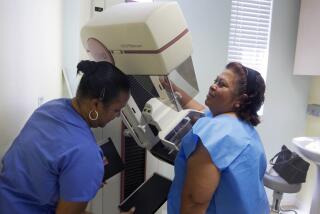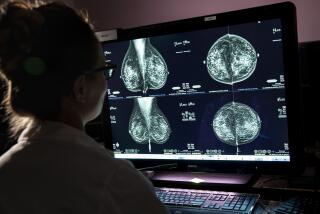Check Your Family’s Medical History to Assess Risk for Breast Cancer
- Share via
Hardly a day goes by without a call from a co-worker, friend or family member with a medical question. Sometimes, it’s about a current medical problem; often it’s a worry about something in the news. One of the most common questions women ask is, “What are my chances of getting breast cancer?”
It’s not surprising this question is coming up so often. After all, breast cancer is the second-most-common cancer in women--exceeded in numbers only by skin cancer. And breast cancer has been getting a lot of press lately. Some of the news has been good, such as the discovery that less radical surgery is just as curative for many early cancers, and the discovery of more effective chemotherapy for women with advanced cancers. Other news has women worried, such as the recent discovery of breast cancer genes.
So what do you tell a woman who’s worried about her risk of developing breast cancer? We would tell her the following:
* The average woman has a one in eight chance of developing breast cancer at some point in her lifetime.
* For some women, the risk is higher or lower than average.
* There are ways to determine if your risk is higher or lower than average.
To assess your level of breast cancer risk, start by determining if you have any risk factors for the disease. A family history of breast cancer is one of the strongest risk factors. Women with a first-degree relative (parent, sibling or child) who has had breast cancer are at greater risk of developing it themselves than women who have no affected relatives. One first-degree relative with breast cancer doubles a woman’s risk; two first-degree relatives with the disease increase the risk approximately five-fold.
Some women actually inherit genetic changes in breast cancer-related genes, placing them at exceptionally high risk of developing cancer. A woman who has inherited an abnormality in breast cancer gene 1 (BRCA1) or breast cancer gene 2 (BRCA2) has a 50% to 60% chance of getting the disease at some point during her lifetime.
If you have already had breast cancer, you have an increased risk of getting it again in the other breast or in a different part of the same breast. Or, if you have had breast biopsies before--particularly if one of the biopsies showed an abnormality--your risk is also increased (even if the result was not cancer).
A diagnosis of “atypical hyperplasia” (an abnormal overgrowth of cells) on a biopsy, for example, is associated with a four- to five-fold increase in a woman’s chances of developing breast cancer.
Prolonged exposure to the hormone estrogen is also thought to increase your risk of breast cancer. If you began menstruating at a young age (before the age of 12), experienced menopause late (after the age of 55) or never had children, you are at greater risk, because women are naturally exposed to high levels of estrogen during the years when they are menstruating. Your risk is also greater if you use birth control pills or hormone replacement therapy after menopause; both contain estrogen.
The National Cancer Institute has developed a brief questionnaire to help you assess your own personal risk of breast cancer. It is available on the institute’s Web site: https://bcra.nci.nih.gov/brc/questions.htm.
Regardless of where you fall on the risk spectrum, regular screening with mammograms is very important. Early detection of breast cancer greatly improves the likelihood that it can be treated successfully. If a cancer is small (less than 2 centimeters) and has not spread beyond the breast at the time of initial diagnosis, the five-year survival rate is as high as 95%. The five-year survival rates for the most advanced cancers are less than 20%.
Mammograms can often detect cancers that are too small for you or your doctor to feel, and are the best available tool for finding breast cancer early. Screening with mammography every one to two years reduces the chances of dying from the disease by about 20% to 30%. Most experts and medical organizations, including the National Cancer Institute and the American Cancer Society, recommend mammography every one to two years, beginning at age 40.
Mammograms are not generally recommended before age 40 because breast cancer is very uncommon in women younger than 40. Nearly 20% of women diagnosed with breast cancer are in their 40s, and about 80% are 50 or older. Mammograms may, however, be indicated for younger women who develop abnormal changes in their breasts, such as a lump or swelling, redness or scaling of the skin, or nipple discharge, as well as younger women considered to be at particularly high risk of developing breast cancer.
Despite the wealth of evidence supporting the use of mammography, many women still do not get them as frequently as they should (if at all). A recent survey by the National Center for Health Statistics found that fewer than 65% of women ages 40 to 64 and fewer than 55% of women ages 65 and older had had a mammogram in the last two years. Don’t make that mistake.
*
Dr. Jonathan Fielding is the director of public health and the health officer for the Los Angeles County Department of Health Services. Dr. Valerie Ulene is a board-certified specialist in preventive medicine practicing in Los Angeles. They can be reached at https://[email protected]. Their column appears the second and fourth Mondays of the month.






